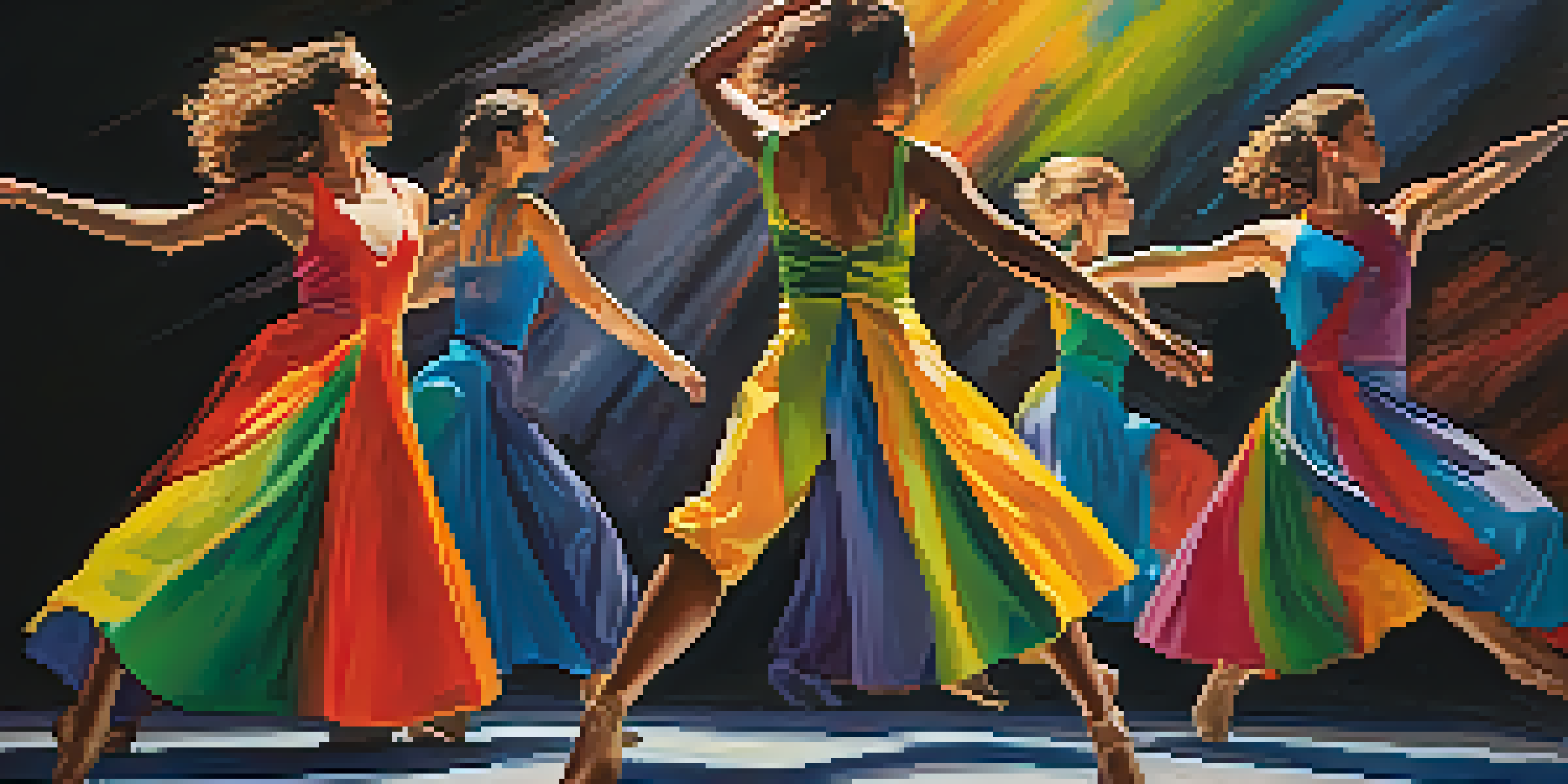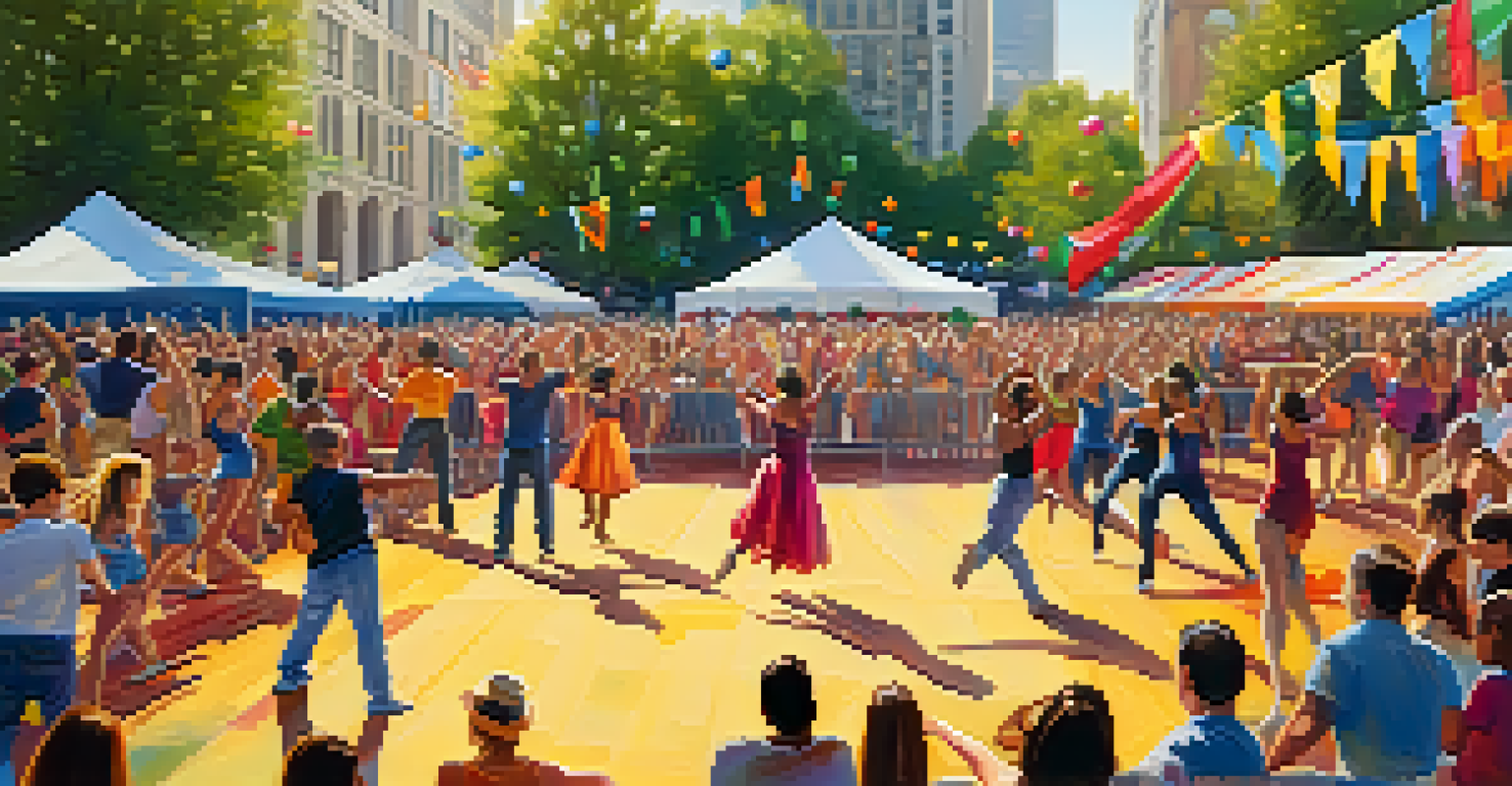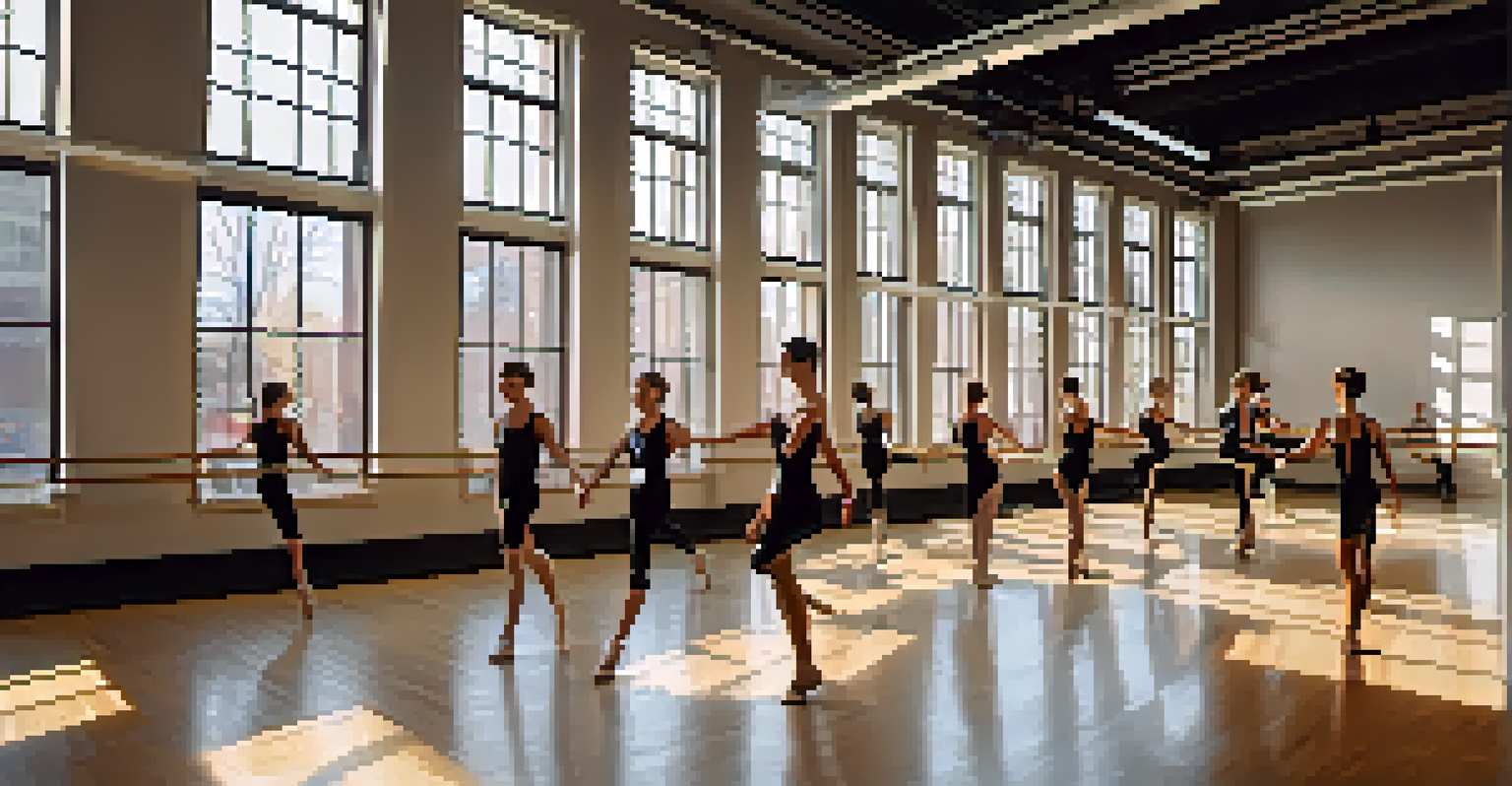Historic Chicago Dance Companies That Changed Modern Dance

The Birth of Modern Dance in Chicago
In the early 20th century, Chicago emerged as a pivotal hub for modern dance, attracting innovative choreographers and dancers. This period saw a departure from traditional ballet, paving the way for new forms of expression. Companies began to explore themes of individuality and cultural identity, reflecting the diverse fabric of the city itself.
Dance is the hidden language of the soul.
One of the key figures during this time was Ruth Page, whose work blended classical ballet with modern techniques. Page's performances were not only visually stunning but also emotionally resonant, appealing to a broader audience. Her influence encouraged other dancers to experiment, leading to a vibrant dance scene.
As modern dance took root, Chicago became synonymous with creativity and experimentation. Dance companies began to flourish, each contributing unique styles and philosophies that would ultimately shape the future of the art form. This foundational era laid the groundwork for the transformative movements that followed.
The Legacy of the Chicago Dance Theatre
Founded in the 1970s, the Chicago Dance Theatre made waves with its innovative choreography and commitment to collaborative work. The company was known for its daring performances that often pushed the boundaries of movement and narrative. Their unique blend of dance, theater, and music captivated audiences, redefining what a dance performance could be.

Under the direction of key figures like Daniel Ezralow and later, Ann Reinking, the company showcased a variety of styles while emphasizing the importance of storytelling. This approach not only made dance accessible but also highlighted its emotional depth. The Chicago Dance Theatre's commitment to originality resonated with both dancers and choreographers alike.
Chicago: A Hub for Modern Dance
In the early 20th century, Chicago became a vital center for modern dance, fostering creativity and new forms of expression.
The company's influence extended beyond its performances; it also fostered a new generation of artists. Many dancers who trained with the Chicago Dance Theatre went on to have successful careers in various dance disciplines. This legacy of mentorship and innovation continues to inspire the Chicago dance community today.
The Impact of the Alvin Ailey American Dance Theater
While primarily based in New York, the Alvin Ailey American Dance Theater has deep connections to Chicago's dance scene. The company's founder, Alvin Ailey, believed in using dance to celebrate African American culture, a philosophy that resonated with many Chicago artists. His commitment to inclusivity and cultural representation influenced local dance companies to embrace diversity in their performances.
The dance is a poem of which each movement is a word.
Alvin Ailey’s iconic work, 'Revelations,' has been performed in Chicago countless times, showcasing the power of dance as a storytelling medium. This piece, drawing from Ailey’s own experiences, speaks to the African American experience, making it a poignant work that resonates with audiences of all backgrounds. The emotional depth and technical skill displayed in 'Revelations' have inspired many dancers in the city.
Ailey's legacy also encouraged Chicago's dance educators to incorporate diverse perspectives and styles into their curricula. This shift has enriched the training of countless dancers, allowing them to express their unique identities. The impact of Ailey’s vision remains evident in the city’s rich tapestry of dance today.
The Influence of Hubbard Street Dance Chicago
Founded in 1977, Hubbard Street Dance Chicago quickly became a beacon of contemporary dance, known for its athleticism and artistry. The company’s innovative choreography often merges classical ballet with modern dance, creating a distinctive style that captivates audiences. This approach has not only broadened the definition of dance but also made it more accessible to the general public.
Hubbard Street’s collaborations with renowned choreographers, including Twyla Tharp and Jiri Kylian, have led to groundbreaking works that challenge traditional forms. Their performances are characterized by intricate movements and emotional narratives, inviting viewers to engage with the dance on multiple levels. This commitment to collaboration has set a new standard within the dance community.
Legacy of Chicago's Dance Companies
Companies like the Chicago Dance Theatre and Hubbard Street Dance Chicago have influenced the dance landscape, mentoring new generations and redefining performance art.
Moreover, Hubbard Street has placed a strong emphasis on education and outreach, bringing dance to diverse audiences across Chicago. Their community programs and workshops foster a love for dance among young people, ensuring that the art form continues to thrive. By nurturing the next generation of dancers, Hubbard Street solidifies its role as a transformative force in modern dance.
The Role of the Joffrey Ballet in Modern Dance
The Joffrey Ballet, established in 1956, has played a crucial role in bridging the gap between classical ballet and modern dance. Known for their willingness to experiment, the company has incorporated contemporary choreography into their repertoire, setting them apart from traditional ballet companies. This willingness to innovate has made the Joffrey a vital player in Chicago's cultural landscape.
One of the Joffrey's notable contributions is their commitment to presenting new works by contemporary choreographers. By commissioning original pieces, they have not only expanded their audience but also provided a platform for emerging artists to showcase their talents. This dedication to new choreography has sparked dialogue about the evolution of dance in modern times.
The Joffrey Ballet has also been recognized for its efforts in making ballet more relatable and relevant to modern audiences. Their performances often incorporate elements of popular culture, making dance more approachable. This innovative approach has attracted a diverse audience, ensuring that ballet remains a vital part of Chicago’s dance scene.
The Importance of Chicago's Dance Schools and Programs
Chicago's reputation as a dance hub is bolstered by its robust dance schools and training programs. Institutions like the School of the Art Institute of Chicago and Columbia College Chicago have nurtured countless dancers and choreographers, providing them with the skills needed to excel in the industry. These schools emphasize a blend of technical training and creative exploration, essential for the development of modern dancers.
In addition to traditional training, many schools focus on fostering individual expression and cultural awareness. By incorporating diverse dance styles and philosophies, these programs prepare students to approach dance with a broad perspective. This holistic approach not only benefits the students but enriches the entire dance community.
Festivals Fuel Dance Innovation
Chicago's festivals and events celebrate the dance community, encouraging collaboration and showcasing emerging talent.
The impact of these educational institutions extends beyond the classroom, as many graduates go on to perform with respected companies or launch their own projects. This continuous cycle of training and performance ensures that Chicago remains a vibrant landscape for modern dance. The commitment to education is a key factor in the city’s enduring influence on the dance world.
Chicago's Festivals and Events Celebrating Dance
Chicago hosts several festivals and events that celebrate the vibrant dance community, drawing in audiences from all over the city and beyond. Events like the Chicago Dance Month and the Chicago Contemporary Dance Festival showcase a diverse array of performances, highlighting both established companies and emerging artists. These festivals not only celebrate the art form but also encourage collaboration among dancers.
These events provide a platform for choreographers to experiment and present new work, fostering a sense of community and innovation. They also create opportunities for networking, allowing dancers to connect with one another and share ideas. This spirit of collaboration is essential for the growth and evolution of modern dance.

Moreover, these festivals often include workshops and masterclasses, further engaging the community and inviting participation. By opening their doors to the public, these events cultivate an appreciation for dance and inspire the next generation of artists. Chicago’s commitment to celebrating dance ensures that the art form remains dynamic and relevant.
The Future of Dance in Chicago: A Continuous Evolution
As we look to the future, Chicago's dance scene continues to evolve, embracing new styles and technologies while honoring its rich history. The city's diverse cultural landscape fuels innovation, allowing dance companies to explore fresh perspectives and narratives. This ongoing evolution ensures that the art form remains vital and resonates with newer generations.
Emerging choreographers are increasingly drawing from various influences, creating works that reflect the complexities of modern life. With the rise of digital media, many artists are experimenting with virtual performances and interactive experiences, reaching audiences in ways previously unimagined. This blending of traditional and contemporary methods is shaping the future of dance in Chicago.
The community's commitment to inclusivity and representation is also a key factor in its future. By continuing to support diverse voices and perspectives, Chicago is poised to remain at the forefront of modern dance. As new generations of dancers and choreographers emerge, the city will undoubtedly continue to inspire and challenge the boundaries of the art form.